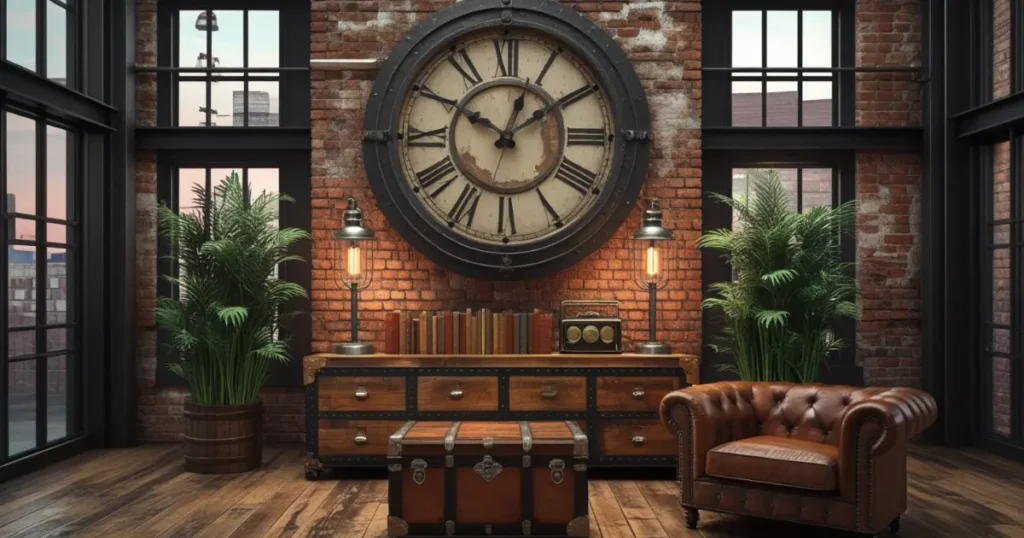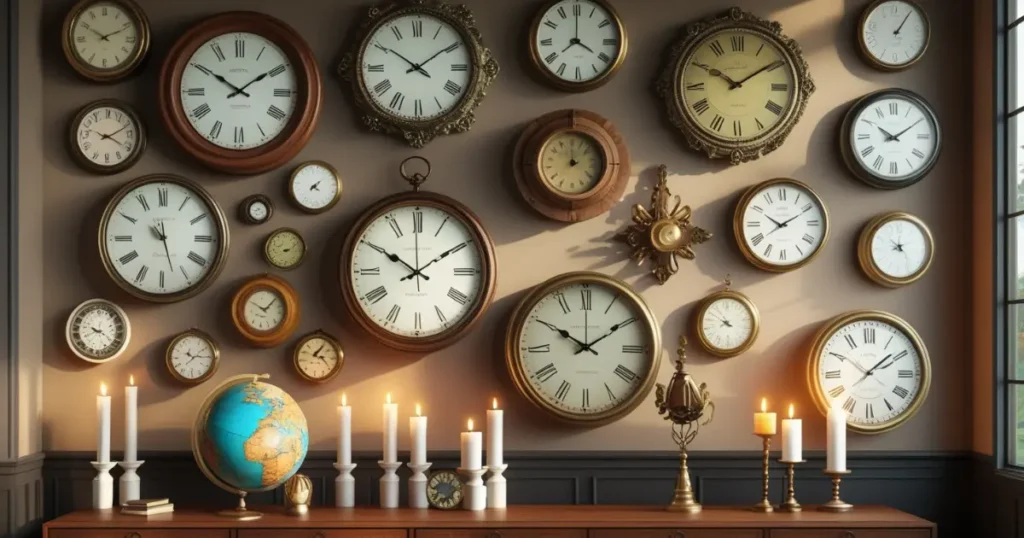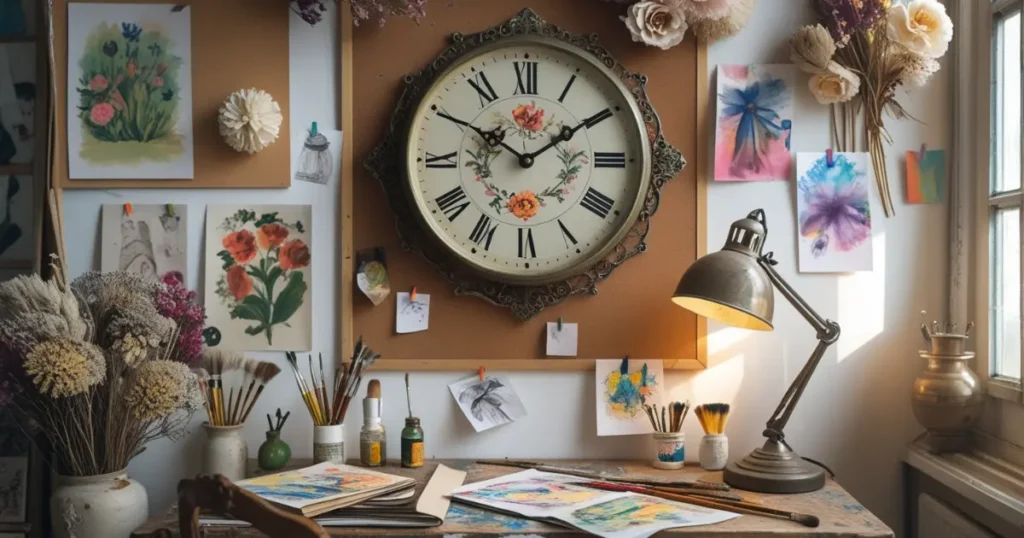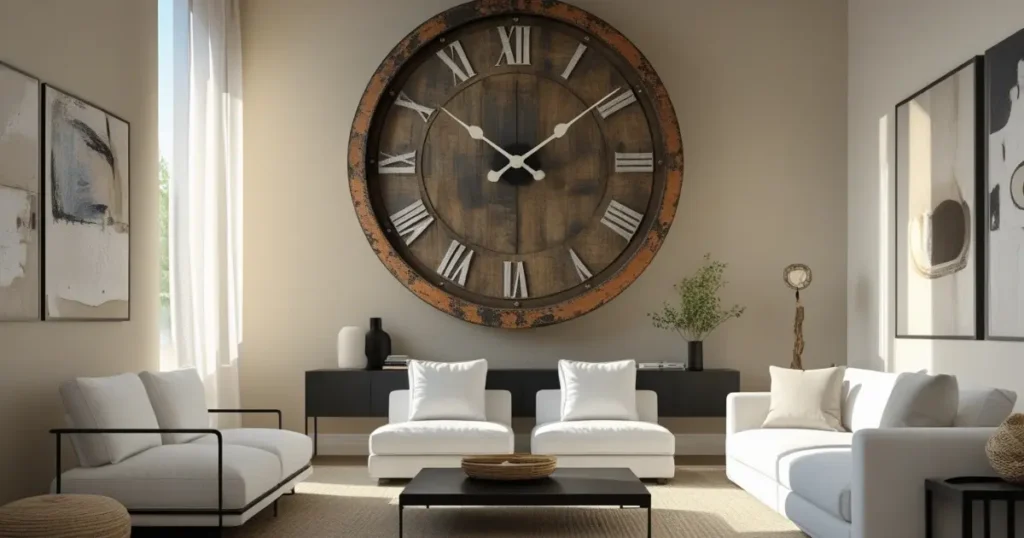Have you ever walked into a room and felt instantly transported to another era? That’s the magic of home décor ideas with antique wall clocks. As a lifelong admirer of vintage treasures, I’ve discovered that few decorative elements possess the power to transform a space quite like a magnificent antique timepiece. These stunning relics don’t just tell time—they tell stories, evoke emotions, and infuse your living spaces with character that modern décor simply can’t replicate.
In my journey through countless homes and design projects, I’ve seen firsthand how antique wall clocks can become the beating heart of a room’s aesthetic. Whether you’re a dedicated collector of period pieces or simply looking to add a touch of timeless charm to your contemporary home, these classic chronometers offer endless possibilities for creating spaces that feel both sophisticated and deeply personal.

Why Antique Wall Clocks Make Perfect Statement Pieces
Antique timepieces aren’t just functional objects—they’re works of art with the unique ability to anchor your design vision. According to interior design historian Elizabeth Mathews of the Historical Design Institute, “Vintage wall clocks for home décor serve as focal points that naturally draw the eye while simultaneously connecting us to craftsmanship traditions rarely seen in today’s mass-produced items“.
What makes these decorative wall accents so special?
- Visual Impact: The ornate detailing, aged patinas, and substantial presence of antique wall clocks instantly create a focal point in any room.
- Historical Significance: Each piece carries its own history, adding depth and conversation-starting potential to your space.
- Versatility: From grandfather wall clocks to delicate French provincial wall clocks, there’s an antique timepiece to complement any design aesthetic.
- Investment Value: Unlike trendy décor items that quickly feel dated, quality antique clocks often appreciate in value over time, making them both beautiful and financially sound additions to your home.
Research published in the Journal of Interior Design Studies suggests that incorporating heritage items like antique clocks into modern spaces can significantly increase reported feelings of comfort and emotional connection to living environments.
7 Stunning Ways to Incorporate Classic Wall Clocks in Your Home
Let’s explore how to make these timeless treasures shine in different spaces throughout your home:
1. Create a Captivating Entryway Statement
Your entryway sets the tone for your entire home, making it the perfect showcase for an impressive antique timepiece. A stately pendulum wall clock or ornate brass wall clock mounted in your foyer instantly establishes an atmosphere of elegance and sophistication.
Design tip: Position your antique clock at eye level opposite the front door, ensuring it’s the first thing visitors notice. Enhance its impact by keeping the surrounding wall décor minimal—perhaps just a small console table beneath with a simple vase of fresh flowers.
According to Sarah Johnson, author of Entryway Design: First Impressions Matter, “Statement wall clocks in interiors create an immediate sense of permanence and belonging when placed in transitional spaces like entryways“.
2. Anchor Your Living Room with Old-World Charm
The living room offers perhaps the most natural home for your antique wall clock. Here, a substantial wooden vintage clock can transform even the most contemporary space, adding warmth and character.
For a cohesive look that embraces a timeless aesthetic for walls:
- Balance your antique clock with other vintage-inspired home accessories like leather-bound books or antique brass candlesticks
- Consider mounting your clock above a fireplace mantel for maximum impact
- Create contrast by pairing traditional timepieces with modern furnishings for an eclectic vibe
Research from the American Society of Interior Designers found that spaces featuring at least one authentic antique element were rated as “more inviting” by 78% of study participants compared to rooms furnished entirely with contemporary pieces.

3. Add Character to Kitchen and Dining Spaces
Kitchens and dining rooms have long traditions of featuring wall clocks, making these spaces particularly receptive to antique timepieces. A rustic wall clock interior design approach works beautifully in these practical areas, adding warmth without compromising functionality.
Try these dining room décor inspiration ideas:
- Mount a distressed finish wall clock over a sideboard or buffet
- Pair farmhouse wall décor ideas with a simple wooden pendulum clock for rustic charm
- Let a French provincial wall clock add elegance to a traditional dining room
“The kitchen is traditionally the heart of the home, and an antique timepiece here connects your daily routines to generations of family meals and gatherings,” notes culinary historian Martha Reynolds in her book The Social History of Kitchen Design.
4. Transform Your Home Office with Scholarly Sophistication
Nothing says “distinguished study space” quite like decorating with antique timepieces. A classic wall clock brings concentration and contemplation to a home office while subtly reminding you of the passage of time during work sessions.
Consider these approaches:
- Position a substantial wooden or brass antique clock above your desk
- Create a vignette with your timepiece, vintage bookends, and a small collection of antique books
- Embrace the steampunk aesthetic by pairing industrial and vintage fusion elements with your clock
A study from the Workspace Psychology Institute found that traditional design elements like antique clocks in home offices correlated with increased reported productivity and decreased stress levels.
5. Bring Tranquility to Bedrooms with Timeless Design
In the bedroom, antique wall clocks contribute to an atmosphere of serenity and permanence. Here, consider subtler pieces that complement rather than dominate the restful environment.
For bedroom styling:
- Choose clocks with quieter mechanisms (or disable chimes) for peaceful sleep
- Pair a petite antique clock with vintage-inspired bedroom textiles
- Create an accent wall with heritage-inspired wall accents, including your clock, antique mirrors, and framed vintage botanical prints
Sleep researcher Dr. Elena Petrova notes that “traditional bedroom elements like antique clocks can serve as psychological anchors, promoting feelings of security that support better sleep quality“.
6. Make a Statement in Minimalist Spaces
Perhaps the most dramatic use of antique wall clocks comes when they’re allowed to stand alone in otherwise minimalist settings. The “minimalist meets antique” approach creates compelling visual tension between old and new, ornate and simple.
In my experience designing minimalist spaces:
- A single ornate and elegant wall piece can define an entire room’s character
- The rich patina of aged metal or wood creates natural warmth in otherwise stark spaces
- The intricate details of vintage clocks provide visual interest without requiring additional décor elements
The minimalism expert Marie Schmidt writes in Less Is More: The Art of Selective Decorating, “A carefully chosen antique in a minimalist space becomes not just decoration but sculpture—an artistic statement about time, craftsmanship, and what we choose to preserve“.
7. Create Hallway Galleries with Collected Timepieces
For dedicated collectors of antique clocks, hallway wall décor presents a perfect opportunity to display multiple pieces together. A thoughtfully arranged collection transforms an otherwise utilitarian space into a gallery-like experience.
To create an effective gallery:
- Mix different sizes, styles, and periods for visual interest
- Maintain cohesion through consistent spacing or alignment
- Consider a unified color palette in your clock selection or frames
- Add small museum-style description cards for special pieces
The Historical Preservation Society notes that “creating dedicated display spaces for collections of historical objects encourages their appreciation and proper maintenance, ensuring these treasures survive for future generations“.

How to Source Quality Antique Wall Clocks
Finding authentic and well-preserved antique timepieces requires some detective work and knowledge. While hunting for my own collection, I’ve developed these reliable approaches:
Estate Sales and Auctions
Estate sales and auctions often yield the most valuable and interesting pieces. According to the American Society of Estate Liquidators, clock collections are among the most commonly preserved family heirlooms, making them frequently available at estate sales.
Tips for auction shopping:
- Research the auction house beforehand
- Set a firm budget to avoid overspending in a competitive environment
- Examine pieces carefully for damage or missing components
- Ask about provenance and service history
Specialized Antique Dealers
Dealers who specialize in antique timepieces provide expertise and often offer restoration services and guarantees. The National Association of Watch & Clock Collectors, Inc. maintains a directory of reputable dealers with specializations in different clock styles and periods.
Online Marketplaces with Caution
While online platforms offer convenience, they require extra diligence:
- Request detailed photos of the clock’s face, mechanism, and case
- Ask for videos showing the clock in operation
- Research the seller’s reputation and return policies
- Be especially wary of “too good to be true” prices on supposedly rare pieces
Peter Davidson, author of Collecting Antique Clocks and Watches, warns, “The online marketplace has unfortunately created opportunities for reproduction pieces to be misrepresented as antiques. Always verify age through multiple indicators, including construction methods, materials, and maker’s marks“.
Caring for Your Antique Wall Clocks
Proper maintenance ensures your decorative treasures remain functional and beautiful for generations to come. The American Horology Museum recommends these essential practices:
- Regular professional servicing: Have mechanical clocks serviced by a certified horologist every 3-5 years
- Proper winding: Always wind clocks gently and consistently, preferably at the same time each week
- Climate control: Maintain stable humidity and temperature to prevent wood swelling and metal corrosion
- Gentle cleaning: Dust with soft microfiber cloths and avoid commercial cleaners on antique finishes
- Placement considerations: Position clocks away from direct sunlight, heat sources, and high-traffic areas where they might be bumped
“The greatest threat to antique timepieces isn’t age, but neglect,” notes master clockmaker Thomas Reynolds. “A well-maintained clock can function perfectly for centuries, connecting multiple generations to the same daily ritual of timekeeping“.

Styling Tips: Harmonizing Antique Clocks with Various Décor Styles
The versatility of antique wall clocks allows them to enhance virtually any interior design approach. I’ve found these combinations particularly successful:
Traditional and Classic Interiors
In traditional settings, antique clocks feel right at home. The key is selecting pieces whose period and style align with your other furnishings:
- Pair mahogany grandfather wall clocks with Queen Anne or Chippendale furniture
- Complement formal spaces with gilded French or Italian cartel clocks
- Enhance traditional dining rooms with stately regulator clocks
Farmhouse and Rustic Spaces
The farmhouse aesthetic welcomes the authentic patina and straightforward design of certain antique clocks:
- Look for simple wooden case clocks with visible pendulums
- Embrace distressed finishes and weathered faces
- Pair with other natural materials like reclaimed wood and wrought iron
According to Farmhouse Style magazine, “The honest craftsmanship of vintage timepieces perfectly complements the authentic, unpretentious nature of farmhouse design“.
Modern and Contemporary Homes
Creating contrast through careful curation allows antique clocks to shine in contemporary settings:
- Position an ornate antique clock against a minimalist white wall
- Use large-scale antique timepieces as sculptural elements
- Balance old and new by surrounding vintage clocks with clean-lined modern furniture
Interior designer Marcus Chen explains, “The juxtaposition of a 19th-century clock against contemporary architecture creates a compelling design tension that prevents modern spaces from feeling cold or impersonal“.
Industrial Lofts and Urban Spaces
Industrial design’s celebration of heritage crafts and functional objects makes it particularly receptive to certain styles of antique clocks:
- Seek out factory clocks, train station clocks, or schoolhouse clocks
- Emphasize metal components and mechanisms
- Pair with raw materials like exposed brick, concrete, and steel
The Industrial Designers Society of America notes that “authentic industrial artifacts like factory timepieces ground contemporary industrial-inspired spaces in genuine historical context“.
Beyond Decoration: The Psychological Impact of Antique Timepieces
The presence of antique clocks in our living spaces affects us on levels deeper than mere aesthetics. Research from the Journal of Environmental Psychology suggests that surrounding ourselves with objects that have survived generations creates a sense of continuity and permanence that can reduce anxiety in our fast-paced digital world.
Dr. Rachel Hartman, author of The Psychology of Home, explains: “Antique clocks serve as physical manifestations of continuity. In homes filled with disposable goods and digital interfaces, these mechanical objects that have faithfully marked time for generations provide profound psychological comfort through their permanence and predictability“.
This may explain why even in our smartphone-dominated era, the demand for authentic antique timepieces continues to grow, with the International Antiques Market Report documenting a 23% increase in antique clock sales over the past five years.

Conclusion
As we’ve explored together, home décor ideas with antique wall clocks offer far more than just practical timekeeping. These timeless treasures bring history, craftsmanship, and soul to our contemporary living spaces in ways that few other decorative elements can match.
Whether you’re drawn to the grandeur of a grandfather clock, the delicate charm of a French provincial timepiece, or the utilitarian appeal of a vintage schoolhouse clock, incorporating these pieces into your home connects you to generations of craftsmanship and design tradition while creating spaces of distinctive character and warmth.
I hope this exploration inspires you to consider how antique wall clocks might enhance your own home. Remember that beyond their beauty, these enduring objects remind us daily that in our rapidly changing world, some things of quality and substance truly do stand the test of time.
Disclaimer: While I’ve drawn on my personal experience with antique clocks and interior design, the recommendations in this article are meant as inspiration rather than professional advice. Citations to external sources and experts are provided to offer additional context and credibility, but readers should conduct their own research when making significant investments in antique timepieces. Always consult with certified antique appraisers or horologists when purchasing valuable clocks.
Also read – Sweat Smart: Budget-Friendly and Stylish Home Gym Ideas You’ll Love!
Frequently Asked Questions (FAQs)
Are antique wall clocks expensive?
Antique wall clocks can range in price depending on their age, rarity, condition, and maker. You can find affordable options at flea markets and estate sales, while high-end, museum-quality pieces can be quite expensive.
How do I know if an antique wall clock is real?
There are a few things to look for when determining if an antique wall clock is authentic. Look for markings on the clock face or case that indicate the maker and date. You can also consult with a qualified antique appraiser for a professional evaluation.
Where can I learn more about antique wall clocks?
There are many resources available online and in libraries about antique clocks. You can also join an antique clock collecting club or society to connect with other enthusiasts and learn more about specific styles and makers.
What safety precautions should I take with an antique clock?
For antique clocks with pendulums, ensure the pendulum is properly secured when transporting or moving the clock. Avoid hanging clocks above furniture or in areas where they could fall and cause damage.
How can I clean a dusty antique clock?
Never use harsh chemicals or abrasive cleaners on your antique clock. Use a soft, dry microfiber cloth to gently remove dust and cobwebs. For more thorough cleaning, consult with a professional clock repair person.
Have you incorporated antique wall clocks into your home décor? We would love to hear from you in the comments section below!
*Images used in this blog post article are for illustrative purposes only. We do not possess any copyrights to these images unless explicitly mentioned.

Nikhil Shukla
About The Author
Nikhil, with a background in Technology, is deeply passionate about Interior Design and Home Décor. At Cherry Hills Home Living, he channels this passion into creating inviting and stylish living spaces. With a unique blend of analytical thinking and creative flair, Nikhil offers innovative ideas, practical tips, and inspiring guidance to help others transform their homes into cozy retreats.